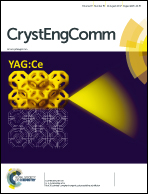Muscovite mica as a growth template of PC61BM crystallites for organic photovoltaics†
Abstract
Controlling the microscopic organization of active components is crucial for the performance of organic photovoltaic (OPV) cells. In this work, (001) muscovite mica was used as a growth template to study the formation of PC61BM crystallites in the active layer structure of OPV cells. The structures were spin-coated from a PC61BM : P3HT solution and subsequently annealed. The parameter range to produce layers with high surface density of (sub)micrometer sized PC61BM crystallites was significantly larger for mica than for other substrates. The enhanced PC61BM nucleation is attributed to an epitaxial relation between the mica surface and PC61BM, which was found to crystallise in a hexagonal crystal structure. Through a float-off procedure, the active layer was transferred from the mica substrate to a conductive substrate, which formed the basis of the transferred inverted solar cell. A power conversion efficiency of 2.1% was obtained for this transferred device, which with a 22% higher short-circuit current density outperforms its conventional counterpart that was directly produced on the conductive substrate. A set-up for simultaneous laser beam induced current (LBIC) and surface reflection analysis revealed that the increased current density originates from large circular areas with a radius of about 10 μm around the PC61BM crystallites.



 Please wait while we load your content...
Please wait while we load your content...